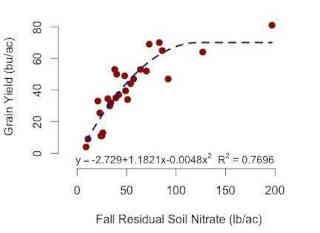By Dorivar Ruiz Diaz
An article in this eUpdate issue gives a great summary on planning the best wheat fertility program through timely soil testing. This article addresses the correlation between the amount of nitrate in the soil profile and wheat yield.
Taking 24-inch soil profile-N samples in the fall has been a recommended practice for making an N recommendation for winter wheat for many years. However, due to the mobility of nitrate-N in the soil, soil test values observed in the fall may be different from values observed in the spring, particularly on soils prone to leaching. Because many producers wait until spring green-up to make their N application, does soil sampling in the fall for nitrate-N really provide useful information for N management in wheat? That is a legitimate question.
Analysis of yields taken from K-State research plots that received no N fertilizer shows a strong positive relationship with fall soil profile nitrate-N (Figure 1).

Figure 1. Relationship between fall soil profile nitrate-N level and wheat yield with no N fertilizer applied. Graph by Dorivar Ruiz Diaz, K-State Research and Extension.
We found that at low soil nitrate levels, wheat yields responded well to applied fertilizer. We also found that when fall soil profile nitrate-N levels are greater than 80 to 100 lb/acre, it is unlikely the site will respond to additional fertilizer N applied in the spring.
In short, a strong relationship was found between wheat yield and fall nitrate-N levels from 24-inch profile soil test analyses when no N fertilizer was applied. Although new practices have been developed to improve N management in winter wheat, soil sampling in the fall for nitrate-N remains an important practice to manage N efficiently and can result in considerable savings for producers.
When soil sampling for N is not done, the K-State fertilizer recommendation formula defaults to a standard value of 30 lb/acre available N. In this particular dataset, the average profile N level was 39 lb N/acre. However, the N level at individual sites ranged from 11 to 197 lbs N/acre. Most recommendation systems default to a standardized set of N recommendations based on yield goal and/or the cost of N. Without sampling for N or using some alternative method of measuring the soil’s ability to supply N to a crop, such as crop sensing, the recommendations made for N will be inaccurate, resulting in a reduction in yield or profit per acre and increased environmental impact.
Failure to account for the N present in the soil wastes a valuable resource and can result in excess foliage, increased plant disease, inefficient use of soil water, and reduced yield. Soil sampling in fall for nitrate-N can have a significant impact on N recommendations for winter wheat in Kansas soils.
Source : ksu.edu